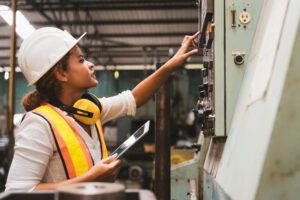
As industries grapple with workforce shortages, rising costs, supply issues, fluctuating demands, and the pressing need to reduce energy usage, multifaceted robotic solutions stand out, ushering in a new era of safety, efficiency, and workforce empowerment. The integration of robotics has become more than a technological advancement; it’s now a strategic necessity.
It’s clear that embracing the power of digital transformation is key in moving forward, but as our CEO, Peter Herweck, recently wrote, keeping humans firmly at the heart of the industrial factories of the future is also an absolute necessity.
Where Industry 4.0 has brought smart factories to the forefront, Industry 5.0 is all about adding the human edge, with more meaningful and efficient collaboration between humans and the machines and systems within a digital ecosystem.
Unlocking the power of industrial robotics for workforce optimization and unprecedented efficiency
According to the IDC’s new Spotlight Paper, worldwide investment in industrial robotic solutions is expected to grow by at least 13% by 2027.
Manpower Group recently reported that 75% of companies in the industrial sector are currently experiencing a talent shortage. An extensive new Korn Ferry report has found that by 2030, more than 85 million jobs could go unfilled because there won’t be enough skilled workers to fill them. Now ranked as the No. 1 driver of manufacturing competitiveness by global manufacturing executives, it seems this lack of skilled talent has reached a critical level.
At a time when widening skill gaps and an aging workforce are creating constant challenges for businesses and are threatening to significantly impact the global economy, how can robots act as a strategic ally rather than a replacement for human labor?
Mitigating shortages, optimizing the workforce, and enhancing efficiency with human-robot collaboration
Whether on the factory floor, in logistics, or even in hazardous environments, robots are valuable assets for streamlining operations, filling skill shortages, increasing operational and energy efficiency, and empowering the existing workforce. The powerful collaborative partnership between humans and today’s robots changes the game entirely for industrial manufacturing businesses, with benefits including:
- Increased productivity & task offloading
- Skill enhancement and heightened innovation
- Improved workplace safety
- Simplified operations and maintenance
By combining the power of digital technologies such as data analytics, machine learning, and integrated robotics systems with the cognitive ability of human workers, industrial businesses can also greatly improve their levels of operational and energy efficiency:
- Energy-efficient operations: Traditional manufacturing processes are often energy-intensive. Robotics can be monitored and programmed for energy-efficient operation, reducing overall energy consumption, waste, and environmental impact. By teaming robotics with highly skilled operators who make decisions based on real-time information, energy consumption and sustainability can be optimized like never before.
- Optimized workflows: By integrating into existing systems, and using technologies like machine learning, robots can adapt in real-time to better meet dynamic production demands. This helps maintain a smooth and efficient workflow, and drives a more effective flow of parts, raw materials, and finished goods, translating to overall operational cost reductions.
- Improved resource utilization and waste reduction: Robotics enable precise control over processes and material usage, resulting in less error and rework, reducing waste and optimizing resource use. Less materials are transported, saving further costs and reducing carbon footprint.
- Higher return on investment (ROI): When modernizing to smart operations, the efficiency of robotics helps industrial organizations recover investment costs faster. Implementation usually requires minimal change to existing production layouts and a smaller footprint, reduced setup time, lower operational costs, and easy integration into existing systems all help increase ROI.
Schneider Electric’s innovative robotic solutions can fill the gaps and boost overall efficiency
When it comes to integrated robotic solutions, Schneider Electric offers a wide array of products, including delta, cartesian, and SCARA robots. We innovate smart conveying with solutions like our Lexium MC12 multi-carrier system, and our digital twin solution for machines, EcoStruxure Machine Expert Twin, enables robotic solutions to be designed and virtually tested before real-world implementation, at the start of a project or when adding to an existing system. This helps optimize design and minimize potential errors which could impact overall safety and performance.
Our latest addition, the Lexium Cobot (collaborative robot), has been specifically designed with safe human-robot collaboration in mind.
These cobots perform uniquely gentle and diligent movements using dynamic torque and speed monitoring and have in-built features such as sensitive collision to reduce the risk of incidents when working alongside humans. Workers can also quickly ‘teach’ the robot where to move, what to pick up, etc., without the need for extensive programming.
With increased productivity and process optimization, Lexium Cobot achieves maximum results with minimum costs. Errors are minimized, safety is maximized, employees have more time to innovate, and productivity increases, ultimately leading to improvements in overall operation.
Embracing the future of work alongside robots
It’s becoming very clear that to stay competitive in the evolving industrial landscape, businesses must embrace the collaborative potential of human-robot interaction and the efficiency gains they offer. By adopting robotic technology, industries can optimize processes, enhance productivity, and contribute to a more sustainable future.
As we move toward Industry 5.0, we believe the synergy between human talent and ingenuity and robotic speed and precision will continue to be a defining factor in the future of industrial automation, driving innovation and fostering the next era of intelligent and energy-efficient manufacturing.
Ready to start reaping the benefits of adding robotics to your operations?
Get more information on Schneider Electric’s robotics solutions
Access Schneider Electric’s Robotics e-guide
Download the IDC Paper: The Rapid Pace of Industrial Robotic Integration
Schneider Electric press release: Digitalization is creating new technology jobs in industries




Add a comment